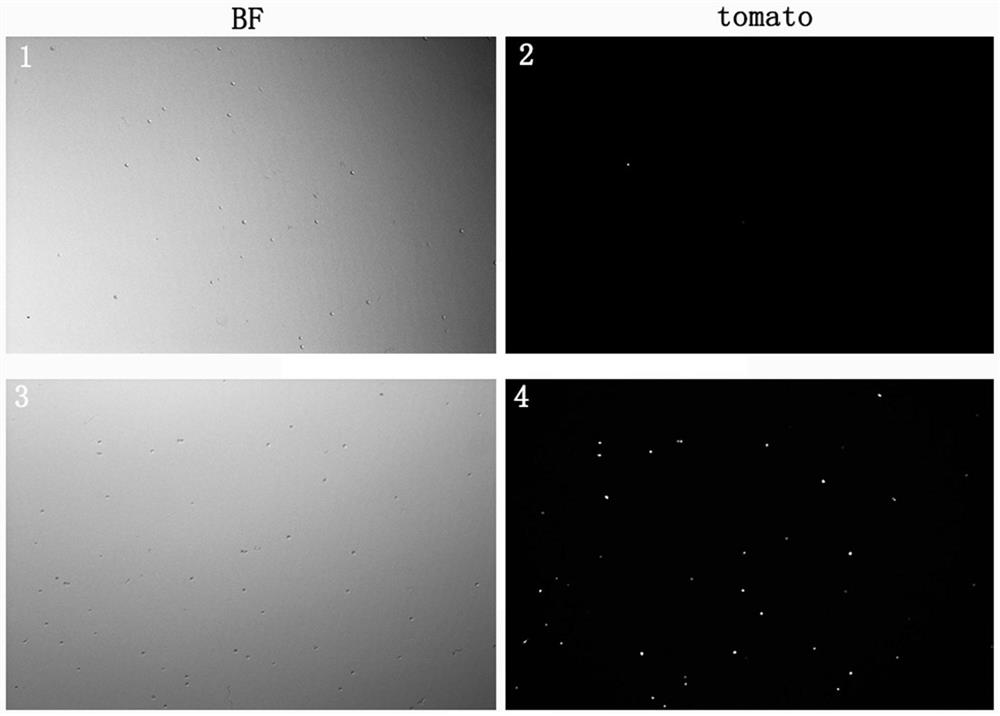Method for separating inner ear FZD10 positive glial cells
A glial cell, positive technology, applied in the field of cell separation and purification, can solve the problems of imperfection, prolonged experiment time, cumbersome process, etc., to achieve the effect of easy operation, ensure cell activity, and avoid serious damage
- Summary
- Abstract
- Description
- Claims
- Application Information
AI Technical Summary
Problems solved by technology
Method used
Image
Examples
Embodiment 1
[0079] (1) Take 20 FZD10-creER+ / - / Rosa26R-tdTomato+ / - double-positive suckling mice 3 days after birth, spray them with alcohol and put them in a biological safety cabinet for operation. Remove the heads of the suckling mice and split them sagittally from the middle of the skull Open, remove the brain parenchyma, cut off the bilateral temporal bones where the cochlea is located, quickly put it into a petri dish filled with cold Hanks solution, carefully dissect the cochlea under a dissecting microscope, remove the cochlea to expose the internal structure of the cochlea, and carefully tear off the periphery The spiral ligament was removed and the organ of Corti was removed, and the remaining modiolus was transferred to a 15 ml centrifuge tube containing cold Hanks solution. Put the 15mL centrifuge tube containing the worm shaft tissue into the centrifuge and centrifuge at 1500rpm for 5 minutes.
[0080] (2) Prepare the enzymatic hydrolysis solution required for digesting cochle...
Embodiment 2
[0092] (1) Take 20 FZD10-creER+ / - / Rosa26R-tdTomato+ / - double-positive suckling mice two days after birth, spray them with alcohol and put them in a biological safety cabinet for operation. The heads of the suckling mice are removed and split sagittal from the middle of the skull , remove the brain parenchyma, cut off the bilateral temporal bones where the cochlea is located, quickly put it into a petri dish filled with cold Hanks solution, carefully dissect the cochlea under a dissecting microscope, remove the cochlea shell to expose the internal structure of the cochlea, and carefully tear off the peripheral The ligament was spiraled and the organ of Corti removed, and the remaining modiolus was transferred to a 15 ml centrifuge tube containing cold Hanks solution. Put the 15mL centrifuge tube containing the worm shaft tissue into the centrifuge and centrifuge at 1500rpm for 5 minutes.
[0093] (2) Prepare the enzymatic hydrolysis solution required for digesting cochlea mandr...
Embodiment 3
[0105] (1) Take 20 FZD10-creER+ / - / Rosa26R-tdTomato+ / - double-positive suckling mice three days after birth, spray them with alcohol and put them in a biological safety cabinet for operation. The heads of the suckling mice are removed and split sagittal from the middle of the skull , remove the brain parenchyma, cut off the bilateral temporal bones where the cochlea is located, quickly put it into a petri dish filled with cold Hanks solution, carefully dissect the cochlea under a dissecting microscope, remove the cochlea shell to expose the internal structure of the cochlea, and carefully tear off the peripheral The ligament was spiraled and the organ of Corti removed, and the remaining modiolus was transferred to a 15 ml centrifuge tube containing cold Hanks solution. Put the 15mL centrifuge tube containing the worm shaft tissue into the centrifuge and centrifuge at 1500rpm for 5 minutes.
[0106] (2) Prepare the enzymatic hydrolysis solution required for digesting cochlea man...
PUM
 Login to View More
Login to View More Abstract
Description
Claims
Application Information
 Login to View More
Login to View More - R&D
- Intellectual Property
- Life Sciences
- Materials
- Tech Scout
- Unparalleled Data Quality
- Higher Quality Content
- 60% Fewer Hallucinations
Browse by: Latest US Patents, China's latest patents, Technical Efficacy Thesaurus, Application Domain, Technology Topic, Popular Technical Reports.
© 2025 PatSnap. All rights reserved.Legal|Privacy policy|Modern Slavery Act Transparency Statement|Sitemap|About US| Contact US: help@patsnap.com


